
18 minute read
HIGH IN THE SADDLE
Out in Naples’ Golden Gate Estates, 53-acre Shore Acres Farm brings elevated French equestrian standards to Southwest Florida.
BY JAYNIE BARTLEY
PHOTOGRAPHY BY BRIAN TIETZ

It’s a quiet November morning when I drive down White Boulevard in Naples’ Golden Gate Estates to tour Shore Acres Farm. On a back road, asphalt turns to gravel and residential streets fade into farmland with trucks carting pallets of flowers from the teeming plots. Eventually, I see horses grazing beyond a palm-lined driveway that leads to the back of the farm. Co-owner Janie Yag waits at the gate’s entrance in a golf cart, which we use to traverse the 53-acre property she and her husband, Mike, transformed into a horse farm with stables for boarding around 50 horses, riding areas and training with elite equestrians.
“Watch this guy go—he’s 74 years old. And, he’s trained all over the world in his lifetime,” Janie says, gesturing to a gentleman smoothly coaxing a chocolate-brown Selle Français around the perimeter of the property’s 14,500-square-foot, covered arena the Yags outfitted with soft, hoof-safe and quick-draining sand footing. It’s one of many areas for the gentle giants to gallop throughout the sprawling greenspace, including a competition-size arena and a 5-acre open field for free-range riding.
The Yags recently bought a smaller barn in Wellington to keep their horses when they visit during the winter showing season. While Janie does not compete, she calls herself a “horse advocate,” cheering on professional riders from the Shore Acres team at shows throughout South Florida. The couple considered building the farm in Wellington but felt emotionally tied to Naples, where Mike’s dad lived for nearly 33 years. Determined to create something new for the area, they found a 22-acre plot (which they soon added onto) and built Shore Acres from the ground up.
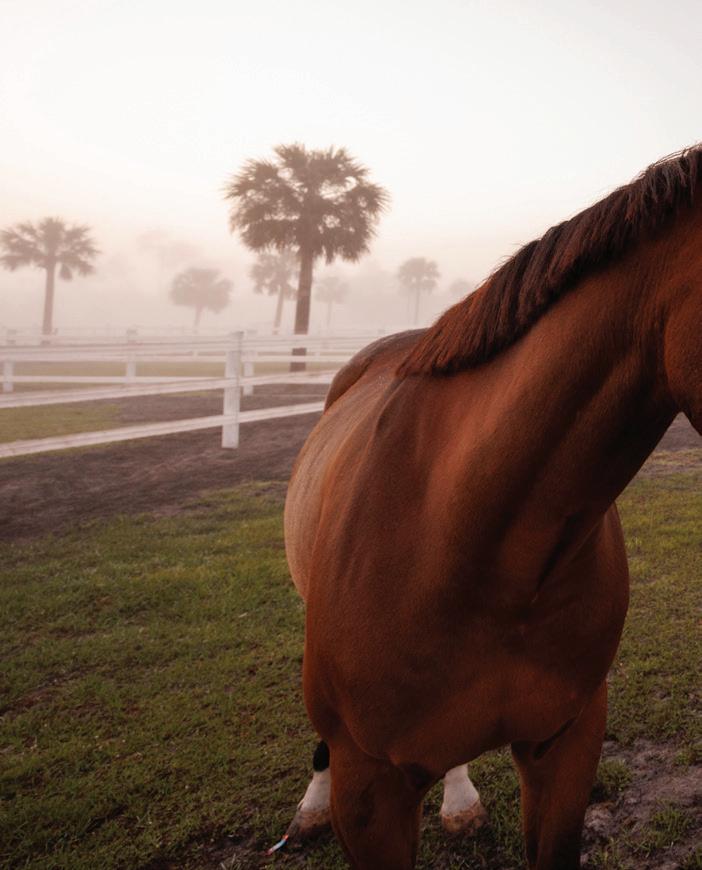
Janie, a former real estate agent and interior designer, loved riding horses with her mom as a kid but didn’t return to the sport until 2018, shortly after her mother passed. Mike, who had recently lost his father, saw his wife struggling to cope and suggested she start riding again to cheer her up. After a few lessons, she was hooked. She dove into research and fell in love with French horses, known for their athletic builds and stellar jumping ability. She bought her first Selle Français, Quaker de Kreisker, from a breeder in France in 2018. “As I left the stable [the breeder] ran to me with a dusty photo, ‘This is Quaker’s mom, Stella,’ he said,” she says. “It set me on my French horse journey.” The man spoke almost no English, but she could see the love that ran through his veins for the athletic breed. And so her French equestrian obsession began.
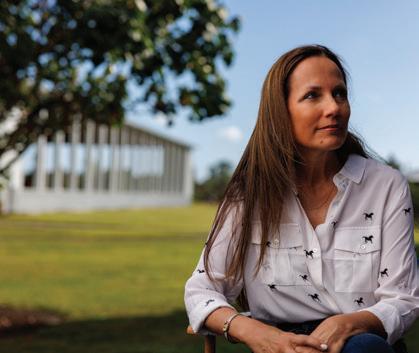





More riders and trainers trot by on towering, muscular steeds as we make our way from the arena to the front of the farm. Since most of her horses are Selle Français, known to be larger and stronger than other breeds, handling them takes honed skill. Most of her clients, who can ride her 17 horses (and counting) while on the grounds, are advanced equestrians—a mix of retired pros looking for a leisurely ride, active international competitors seeking a plush practice arena and talented teens looking to train with Janie’s team. And all her trainers have come up through France’s equine circuit, where Janie says that riders, breeders and brokers live and breathe the equestrian lifestyle—it’s more than a sport or hobby. In 2011, UNESCO inscribed French equitation on its Intangible Heritage Representative List, which recognizes and promotes unique cultural traditions. “It’s their heritage,” Janie says. She and Mike also work with her trainer, Tony Cadet, to find and sell the best horses and ponies from farms in France.
Up front, visitors are greeted by hedges trimmed to spell out ‘S.A.F.’ Mike spearheads landscape upkeep, with a team of groundskeepers, while maintaining the head position at the brand-engagement company he founded nearly 40 years ago in Massachusetts. “I’m not trained to be an architect, or a landscape architect, or a civil engineer,” he jokes. Since opening in 2019, Janie and Mike have expanded Shore Acres beyond its equestrian roots. They recently hosted their first wedding, covering the sandy floor of the covered arena with Trex composite flooring and stringing bistro lights for a romantic reception area. And, in late November, they welcomed the Collier County Sheriff’s Office for equine search-and-rescue training, which Janie explains is a highly effective tool in Florida’s flat terrain.




Shore Acres is dreamy and intentional. Old Florida-style stables and arenas—constructed by Port Charlotte’s Morton Buildings to sustain a Category 5 hurricane—and a white-oak hot walker (like a treadmill, horses use the motorized machine for exercise) from Wellington’s respected manufacturer MK Horse Walkers live in harmony with the Yags’ contemporary home, which fronts the compound. Native palms and pines frame the acreage, with a private nature trail Mike built to loop through the wooded area and another just outside the facility. They worked with Naples’ Jukins Irrigation to install innovative irrigation systems throughout the property. Jukins is one of the only contractors they hire for upkeep; the rest they handle in-house with their tight-knit team. Sustainable measures naturally occur as the Yags attempt to keep the budget and workload in check: Onsite composting, recycled rubber tread used in the barns and self-watering stations in each paddock are part of the daily cycles.
Janie moves swiftly and efficiently, riding boots crunching on gravel as she leads me to the 18-stall main barn. My eyes are drawn to the modern farmhouse-style chandelier hanging from the peak of the vaulted ceiling. “People spend so much time here, so you’ve got to have the WiFi and the music,” she says. With competing riders and trainers flying in, accommodations were a must. She gestures to a suite that houses their newest trainer, Camille Francois, an elite rider from France who competes in jumping competitions for the farm. Industry veteran Jo Lourden has been on since the beginning, helping Janie tend to the animals and office needs. They also have a home on the compound for their lead groom, Jesus Arguello, so he can be on-call to care for the horses or transport them to a vet if the need arises, and they’re building a new barn with a two-bedroom apartment to board more trainers and competitors.

Naples’ Jukins Irrigation is one of the only contractors the Yags hire to maintain their sustainable, water-saving system; Janie and her husband, Mike, handle the rest of the farm’s upkeep with the groundskeepers. Janie’s background in interior design shows through the farmhouse-chic barns, while Mike works his magic with the landscape.
In his first season competing in Wellington, equestrian Tony Cadet—who trains Janie and rides for the Shore Acres team—placed above greats, including Jessica Springsteen, Bruce Springsteen’s daughter who competed in the 2022 Olympics. “He has a near-perfect record this season,” Janie says of Tony’s Selle Français, All Star Del Caballero.

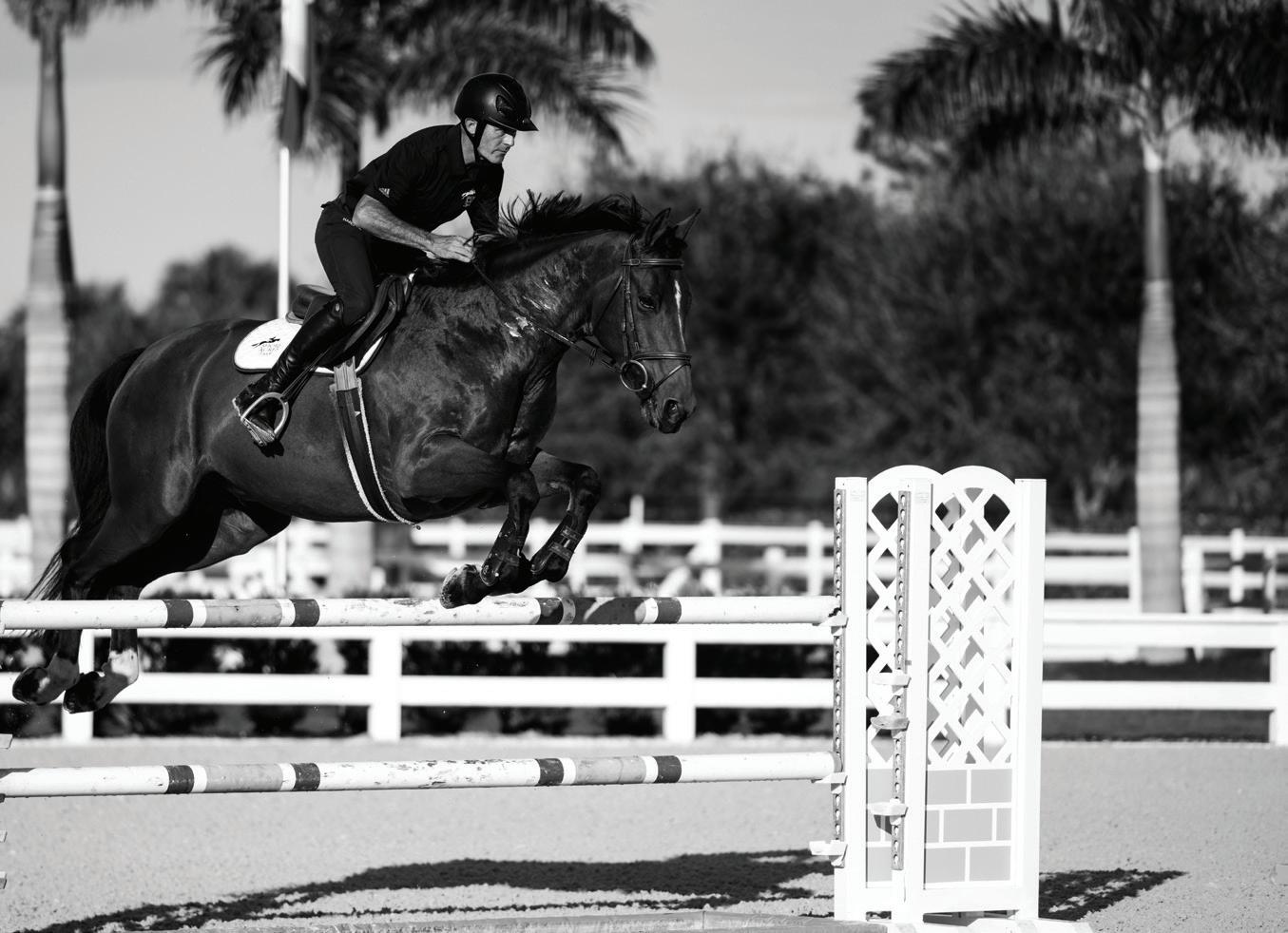
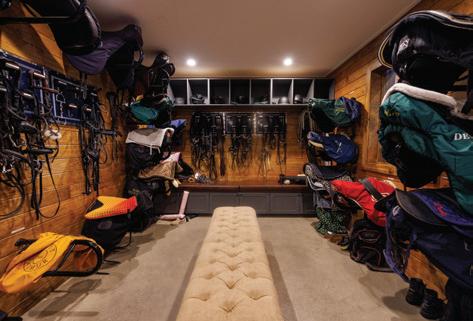
Janie started riding as a child and returned to the sport as a source of comfort after her mother passed away six years ago. Her first Selle Français, Quaker de Kreisker, inspired an obsession with French equine life.


A rainbow of overlapping ribbons lines a wall of the farmchic lounge Janie designed for riders to kick back and have a snack or cold drink. She met Tony, who she currently trains with, “on accident” when purchasing her second horse from Tony’s farm in Brittany, France. After a more than 20-year career riding and training young horses in France, it was a dream opportunity for Tony to ride and compete in Wellington (“It’s the mecca,” Janie says). He rides for Shore Acres in competitions and has built a fan base since his first season when he placed above Wellington greats, including Georgina Bloomberg and Jessica Springsteen, Bruce Springsteen’s daughter who competed for the U.S. in the 2022 Olympics in Tokyo. This year, he took home the first-place medal in the 1.40-meter category (an advanced height for jumps), placing above 90 other contestants, including other Olympians. “When our trucks pull up [in Wellington], you can hear everyone chanting for him,” Janie says. “They don’t care that Shore Acres is there; they just want to see Tony.”
We wrap our tour back at the covered arena, where the gentleman rider has moved on to practice jumps on the competition-size open arena nearby. As I’m about to leave, Janie pulls me back to the golf cart for one more stop. Back inside the barn, she grabs a letter pinned to the fridge. Former French Olympian Marcel Rozier wrote to petition for Tony’s U.S. visa. “This man is a legend, and he wrote this for Tony,” Janie says, kicking the credit back to her team. “We are so blessed here—no kudos to me.”


Rooted in Place
The Walsh family has spent two generations making a mark on Southwest Florida with their stylish and sustainable landscape designs that will stand for years to come.
Chances are, you’re well-acquainted with R.S. Walsh Landscaping. Over the past 40 years, the company has earned a stellar reputation for one-of-a-kind, sustainable tropical designs that perfectly complement Florida’s architectural styles while meeting the specific needs of a site. Before Hurricane Ian ravaged Sanibel Island, their lush 7-acre garden center had long been a favorite spot for locals to wander and dream. Post-Ian, the Walshes were some of the first on the scene, arriving via boats and barges to survey the damage, clear debris and provide much-needed fuel to residents.
The dedication to the community and land is nothing new— family patriarch and company founder Robert “Bob” Walsh has been getting his hands dirty around Southwest Florida since childhood. “My father was with the lead plant inspector for three counties at the State Department of Agriculture,” Bob says. “We lived right next door to [A.W.] Kelley’s Gardens in Fort Myers. That was my first playground from the time I turned 2.” By the time he was 10, he was working there every day after school and learning as much as he could from owner and horticulturist Arthur Kelley. “He was so giving of his knowledge,” Bob says.
Bob studied at Edison Community College (now known as Florida SouthWestern State College) and jumped right back into landscaping after graduation for a more hands-on higher education. He worked under George Causey (“One of the finest landscape designers in Southwest Florida,” Bob says), who was well-known for his projects, like South Seas Island Resort.

“I also trained with Robert Wood, one of the most creative people I’ve ever known. We’d spend all day laying things out, draw until midnight or 1 a.m., and then we’d do it all again the next day,” Bob says. He credits the Oxford-trained landscape designer for introducing him to a tropical modern plant selection of ferns, palms, bromeliads and philodendrons.
That knowledge allowed him to put down roots of another kind. Bob met his wife, Lisa, through mutual friends, and it didn’t take long for love—and other things—to bloom. “Right after we got married, we started planting a vegetable garden together every year,” Lisa says. “Now, I have a flower garden that’s everchanging.”
The couple also shared a can-do spirit. They launched their business in 1983, even though they didn’t exactly have money to burn back then. “I had a pickup truck and $3,000,” Bob says with a laugh. “I took $2,000 and spent it on a honeymoon to the Caymans, and I used the rest to buy an open trailer to pull plants and trees around. It was a lot of hard work, but we made for a good team.” While their style tailors to clients’ dreams, the Walshes have a knack for abundant gardens that respect the natural ecosystem and foster a love of nature. Drive through Sanibel and Captiva, and you’ll see lot after lot of theirs, where pygmy date palms line driveways and 40-plus varieties of palms, wild coffee plants and small wildflowers may be interspersed with blooming grasses, citrus groves and buttonwoods for textural scenes. Intimate areas for gathering, playing and conversation typically find their way into Walsh designs.
Today, the company employs more than 75 people, including five landscape designers and architects, at the Fort Myers location. Bob remains involved in design projects and customer relations, and Lisa still handles the finances, while their sons, Jeremy and Justin, are taking on more leadership. Rather than silver spoons, these brothers came into the world with shovels in their hands. “Some of my earliest memories are helping stand up plants at the nursery when it was windy. We’d unload trucks, and I could pick up one 3-gallon pot at a time,” says Jeremy, who earned a horticulture degree from the University of Florida. “We started working in the fields when we were teenagers. I would plant and lay things out, and I always loved seeing how a home and yard evolved over time.” After earning a business degree from the University of Alabama, Justin also returned to the fold.
R.S. Walsh is known for their lushly planted gardens, which live in harmony with their Florida settings and promote healthy ecosystems.

Since the hurricane, the Walsh family has been working around the clock to replant the garden center and their clients’ homes on the island. “We’re pushing so hard and as fast as we can to get a lot back. That’s where more sustainable landscaping comes in,” Justin says. “The vegetation code and environment standards on Sanibel are some of the top in the state, and that’s what keeps that island looking great. Going forward, we’re hoping to help implement some of those ideas across the board to make more properties more sustainable as the sea level rises and the weather changes.” Some of those ideas include adhering to a more native plant palette to reduce the need for fertilizer, bringing in proper dune plantings to protect the interior landscape and prevent storm erosion, and providing proper drainage layouts to direct rainfall runoff properly without impacting neighboring ecosystems.
As for the future of the business? Bob says that’s covered, thanks to his young granddaughters: “They like to play in the flower garden.”
The Walshes’ sons, Jeremy and Justin, have been involved most of their lives and now lead the family business. “Some of my earliest memories are helping stand up plants at the nursery,” Jeremy says.





Family Style
Father-daughter team Barry and Amanda Lantz elevate Naples design with a multidisciplinary approach— and lots of color.
Amanda Lantz still remembers her favorite gift from when she was 8. “I got a chair and ottoman from Santa, and it was in a white bouclé fabric and bullion fringe. It was the best Christmas gift ever,” says the interior designer, who runs Naples’ recently opened Lantz Collective with her father, Barry.
Amanda’s intro to the industry was through osmosis. As a child, her design vet father frequently took her on business trips to the Merchandise Mart in Chicago. “I’d say, ‘Look for a blue floral,’ in the showroom at Kravet. She’d just kind of take off on her own and pull some fabrics,” Barry says. “I’d show her furniture, and I’d explain why this piece was better than that piece. She took it just as well as any client would have.”
A few decades later, Amanda, who also has a background in fashion, has taken the helm of her father’s business as pres- ident, dynamically expanding the brand in volume and reach. The latest initiative: growing into Southwest Florida. The pair brings chinoiserie, flamingo-hued furnishings and regal touches of the Palm Beach Regency style, combined with a gentler Midwestern sensibility, to their boutique, which debuted in 2021, in Naples. (Their Carmel, IN, outfit scored a spot on Architectural Digest’s list of best home decor stores in the country this year). In addition to stocking vintage, antique and contemporary homewares from more than 100 brands in their 12th Avenue South shop, they offer full interior design services from their new studio, nearby on Central Avenue. Repeat clients with homes in both cities made the Naples addition a natural evolution.


Amanda leads the interior design and architectural space planning projects and does all the buying, while Barry lends advice and original artwork (the designer traded his paint swatches for a paintbrush in 2008). The duo appreciates the opportunity to expand their repertoire for their
Florida designs. “When we were thinking through what we wanted the shop to offer, I knew we wanted a lot of color, a lot of pattern. There are a million places to get a white sofa, a white chair,” Amanda says, adding that Naples aesthetes seem more playful in their aesthetic. “They’re more open to patterned fabrics.”
Fabrics are a strong suit for the Lantzes. Barry launched a collection of evocative textiles with industry giant Kravet two years ago. The line shows off the best of Barry, the painter, and his penchant for brilliant hues, geometric forms and abstract landscapes, with forest green chenille, watercolor-like florals and tweedy canvas wallcoverings. When tackling a design, the duo’s approach is synergistic and seamless. While Amanda’s style is more maximalist and Barry leans minimalist, both share a love for color. “I think we read each other’s mind when it comes to the design side,” Amanda says. Rare arguments about projects yield thoughtful outcomes, the two agree. And, Barry often creates art commissions for Amanda’s clients. “We are really completing everything for them,” she says.








The power of the Lantz brand comes from combining the wisdom of age and the unencumbered audacity of youth.
“It’s sort of mixing older and younger ideas together, and you come up with this really great mix,” Barry says. “She brings fresh, and I bring more experience.” The two contribute a commitment to building strong relationships—something Amanda admired in her father from a young age. “[Clients] all just loved him and couldn’t make a decision without him. Those relationships became generational relationships—it wasn’t just that family, it was their children,” she says, adding that many clients have been with the Lantzes for decades.
In all they do, the Lantz Collective keeps family at the center. “He’s truly my best friend. He was way more than a father or a coworker,” Amanda says. Barry echoes: “I always call her my mini-me.”











Two Unique Golf Courses

Perfectly positioned in year round sunshine surrounded by untamed natural beauty
One Beautiful Gathering Place
a Pristine Clubhouse; the Social heartbeat of the community
A Vibrant Private Club Lifestyle


With a Rhythm All It’s Own

Our welcoming and inclusive private club culture creates unlimited opportunities to integrate and meet new friends. Casually understated elegance combined with outstanding member service delivers unforgettable experiences for you, your family and friends. Envisage yoga on the terrace, pampering in the Spa, the inspiration of fellow artists, elevating your golf game, sipping wines from around the world and reveling in abundantly creative dining options and entertainment under the stars – this is where magical moments happen.
With endless golf, racquet and fitness pursuits, supported by a year-round eclectic program of activities and social events, the optimum lifestyle is reimagined at Quail West. One of Southwest Florida’s most prestigious clubs, Quail West’s world class courses and amenities are shared by a limited number of discerning members.

Memberships are currently available exclusively to Quail West residents. We invite you to Call Today to preview the Club’s outstanding amenities and start your journey to Excellence!

Follow Us on Social Media: facebook.com/quailwestFL ◆ instagram.com/quailwestclub


The Secret Garden
Williams Magical Garden Center & Landscape is a treasure trove for rare, collectible plants and the ultimate Mother Nature fix.
While the rows of vining pothos and blooming bougainvillea at Williams Magical Garden Center & Landscape recall the tuckedaway gardens of fairy tales, this nursery is certainly no secret. The powder-blue metal building is easily spotted on Pine Ridge Road, between Taylor Road and Shirley Street, on the outskirts of Naples Art District. Still, when you pop inside, you’re pleasantly surprised by the chic, design-forward oasis that lies within. Roped pendant lights suspend delicately from the towering exposed ceiling and cast a warm glow on the open-air showroom, stocked with Pinterest-worthy arrangements, cuttings dangling from macrame planters, stacks of clay pots, and an assortment of natural coral and shells in baskets. An open door, tucked in a corner near a wall of garden accessories, beckons to the verdant nursery beyond.
“When people come in, it’s kind of like a sacred place,” pot designer Yeroline Salazar says. The current owner, Cheryl Stanley, hired her as a cashier two years ago, when Yeroline was 16. The young plant lover quickly attached herself to Williams Magical’s lead landscape designer, Greg Raglin. Yeroline now works with Greg to bring clients’ visions to reality, whether hunting for a rare alocasia for their collection, creating a custom planter arrangement to gift to a loved one or designing a backyard oasis. “We’re not your typical nursery,” Yeroline says.



Where buying a plant from a big-box store like Home Depot feels like a rescue mission, picking a potted friend from Williams Magical is akin to taking home a prize. They specialize in rare species, like the monstera Thai constellation, with its tie-dye-looking leaves. And everything on the property is shoppable, whether it’s a purple-striped penwiper succulent on a shelf, a heart-shaped philodendron hanging under the gazebo or a mature fiddle leaf fig anchoring a display of bromeliads. The space is subtly divided into sections based on the plant’s light requirements and rarity. The sun-loving varieties surround the uncovered perimeter, the so-called ‘vampires’ are tucked under shaded awnings and the Goldilocks types settle nicely under a tinted screen enclosure. Collectors’ plants pepper the grounds, too.
Respected landscapers Thomas and Mary Williams (Thomas grew the famous bonsai at Disney’s Epcot) originally opened the Pine Ridge location in 2004 after operating landscaping services under the moniker for more than 40 years throughout Collier and Lee counties. Three years ago, Cheryl bought the space, keeping the same Magical name and amping up the atmosphere with chic decor and a relaxing, walkable layout built to inspire. Today, Yeroline and Greg frequently shop wholesalers for ‘mother’ plants to propagate in the greenhouse behind the garden center. Once the ‘babies’ sprout roots, they’re artfully displayed throughout the garden center or in one of Yeroline’s signature “quirky” potted arrangements, often featuring asymmetrical leaves or bold blooms. Yeroline’s current obsession: Scindapsus. The spotted vining plant is commonly known as a satin pothos or silver pothos, though it’s an entirely different species than the low-light-loving houseplant you can find in grocery stores. “They’re funky looking—they have weird textures and shapes,” she muses.



Yeroline says most regulars stop in for rare finds, such as the spotted calatheas that rest under the shaded collectors’ area or the ruffled-edge bromeliads reaching for the sunshine behind the screen enclosure. Others come to clear their mind with a walk through the garden. We go for the enchanting feeling we get basking in the middle of it all.
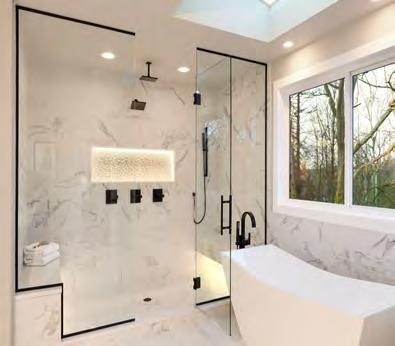







Built to Weather
‘Catastrophic damage will occur.’ Splashed across newspapers and emblazoned on television screens nationwide. Southwest Florida braced for impact. Neighborhoods in Hurricane Ian’s path prepared for devastation. Babcock Ranch felt prepared. After all, it was designed for this very moment.

In 2006, environmental engineer Amy Wicks’ boss at a civil engineering firm tasked her with creating a storm-safe water system for retired NFL player Syd Kitson’s 27-squaremile, solar-powered community, which straddles Charlotte and Lee counties. Working off models of the land from the 1940s, Amy recreated the historic water flow through a functional and sustainable design. Rather than using berms and pipes, she engineered wetlands and recreational greenspaces to easily distribute and detain water during heavy rains, preventing flooding.
More than a decade later, the eastern side of Hurricane Ian’s eyewall sat on top of Babcock Ranch and battered the region for more than six hours. Babcock remained mostly unscathed (save a few fallen trees and displaced shingles). “We were up and running the next day,” Syd says.
The community’s commitment to quality of life and sustainability paid off for the greater region. Its 40,000-squarefoot, Category 5 hurricane shelter housed people from nearby low-lying neighborhoods, and Babcock residents brought food, water and clothing to the shelter.
Since Babcock owns its water and wastewater utility systems, the community never lost water (or power or Internet), so residents could open their homes to first responders for showers and food. The Publix onsite reopened the next day, and two days after the storm, Babcock hosted its weekly Food Truck Friday (one of the many social programs for multigenerational residents at the town’s bustling Founder’s Square). “We brought the town together. There were people here from Fort Myers Beach, Sanibel, Matlacha—all those areas that were impacted,” Syd says. “They were appreciative to have that sense of normalcy.”
At that moment, the town that was best known for its renewable energy quickly became recognized as a model for hurricane-proof, resilient design. “You can plan for an event like we experienced—and we did,” Syd says. “We spent a lot of time engineering, planning, preparing, but the only way that you actually know if you’re going to be successful is when something happens.”


With its underground transmission power lines, 900-acre solar farm, location 25-to-30 feet above sea level, building structures that meet Florida Green Building Coalition standards (which focus on resiliency and energy efficiency), and restored wetlands that provide backup storage for surface water, the town saw minimal storm damage.
Syd admits it costs more to build resiliently, but it’s worth it. “The return on investment is significant, not only from property damage but also from the loss of life, preventing anybody from actually getting hurt,” he says.
Thanks to its recreated wetlands, underground powerlines and 900-acre solar farm, Babcock Ranch faced little damage in Hurricane Ian. The town never lost power and was up and running, with a reopened Publix and a food truck rally within days.














